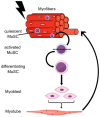Epigenetic Erosion in Adult Stem Cells: Drivers and Passengers of Aging
- PMID: 30501028
- PMCID: PMC6316114
- DOI: 10.3390/cells7120237
Epigenetic Erosion in Adult Stem Cells: Drivers and Passengers of Aging
Abstract
In complex organisms, stem cells are key for tissue maintenance and regeneration. Adult stem cells replenish continuously dividing tissues of the epithelial and connective types, whereas in non-growing muscle and nervous tissues, they are mainly activated upon injury or stress. In addition to replacing deteriorated cells, adult stem cells have to prevent their exhaustion by self-renewal. There is mounting evidence that both differentiation and self-renewal are impaired upon aging, leading to tissue degeneration and functional decline. Understanding the molecular pathways that become deregulate in old stem cells is crucial to counteract aging-associated tissue impairment. In this review, we focus on the epigenetic mechanisms governing the transition between quiescent and active states, as well as the decision between self-renewal and differentiation in three different stem cell types, i.e., spermatogonial stem cells, hematopoietic stem cells, and muscle stem cells. We discuss the epigenetic events that channel stem cell fate decisions, how this epigenetic regulation is altered with age, and how this can lead to tissue dysfunction and disease. Finally, we provide short prospects of strategies to preserve stem cell function and thus promote healthy aging.
Keywords: adult stem cells; aging; differentiation; epigenetic regulation; hematopoietic stem cells; muscle stem cells; self-renewal; spermatogonial stem cells; tissue maintenance.
Conflict of interest statement
The authors declare no conflict of interest.
Figures



References
Publication types
Grants and funding
LinkOut - more resources
Full Text Sources

